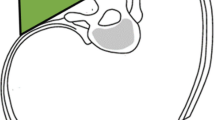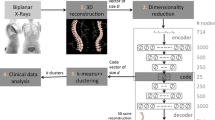Abstract
Markerless 3D surface topography for scoliosis diagnosis and brace treatment can avoid repeated radiation known from standard X-ray analysis and possible side effects. Combined with the method of torso asymmetry analysis, curve severity and progression can be evaluated with high reliability. In the current study, a machine learning approach was utilised to classify scoliosis patients based on their trunk surface asymmetry pattern. Frontal X-ray and 3D scanning analysis with a clinical classification based on Cobb angle and spinal curve pattern were performed with 50 patients. Similar as in a previous study, each patient’s trunk 3D reconstruction was used for an elastic registration of a reference surface mesh with fixed number of vertices. Subsequently, an asymmetry distance map between original and reflected torso was calculated. A fully connected neural network was then utilised to classify patients regarding their Cobb angle (mild, moderate, severe) and an Augmented Lehnert-Schroth (ALS) classification based on their full torso asymmetry distance map. The results reveal a classification success rate of 90% (SE: 80%, SP: 100%) regarding the curve severity (mild vs moderate-severe) and 50–72% regarding the ALS group. Identifying patient curve severity and treatment group was reasonably possible allowing for a decision support during diagnosis and treatment planning.

Graphical abstract





Similar content being viewed by others
References
Bryan R, Mohan PS, Hopkins A (2010) Statistical modelling of the whole human femur incorporating geometric and material properties. Med Eng Phys 32:57–65
Cobb RJ (1948) Outline for the study of scoliosis, instructional course lectures. Am Acad Orthop Surg 5:261–275
Doody MM, Lonstein JE, Stovall M, Hacker DG, Luckyanov N, Land CE (2000) Breast cancer mortality after diagnostic radiography: findings from the U.S. scoliosis cohort study. Spine (Phila Pa 1976) 25(16):2052–2063
Drerup B (1978) (Application of Moiré topography to diagnosis and documentation of anomalies of the trunk (author’s transl)). Z Orthop Ihre Grenzgeb 116(6):789–784 German
Drerup B (1984) Principles of measurement of vertebral rotation from frontal projections of the pedicles. J Biomech 17(12):923–935
Drerup B (1985) Improvements in measuring vertebral rotation from the projections of the pedicles. J Biomech 18(5):369–378
Drerup B (2014 Dec 12) Rasterstereographic measurement of scoliotic deformity. Scoliosis. 9(1):22
Drerup B, Hierholzer E (1992) Evaluation of frontal radiographs of scoliotic spines--part I. measurement of position and orientation of vertebrae and assessment of clinical shape parameters. J Biomech 25(11):1357–1362
Drerup B, Hierholzer E (1992) Evaluation of frontal radiographs of scoliotic spines--part II. Relations between lateral deviation, lateral tilt and axial rotation of vertebrae. J Biomech 25(12):1443–1450
Drerup B, Hierholzer E (1994) Back shape measurement using video rasterstereography and three-dimensional reconstruction of spinal shape. Clin Biomech (Bristol, Avon) 9(1):28–36
Drerup B, Hierholzer E (1996) Assessment of scoliotic deformity from back shape asymmetry using an improved mathematical model. Clin Biomech (Bristol, Avon) 11(7):376–383
Drerup B, Ellger B, Meyer zu Bentrup FM, Hierholzer E (2001) Functional rasterstereographic images. A new method for biomechanical analysis of skeletal geometry. Orthopade. 30(4):242–250
Galbusera F, Casaroli G, Bassani T (2019) Artificial intelligence and machine learning in spine research. JOR Spine 2(1):e1044
Ghaneei M, Komeili A, Li Y, Parent EC, Adeeb S (2018) 3D Markerless asymmetry analysis in the management of adolescent idiopathic scoliosis. BMC Musculoskelet Disord 19(1):385
Ghaneei M, Ekyalimpa R, Westover L, Parent EC, Adeeb S (2019) Customized k-nearest neighbourhood analysis in the management of adolescent idiopathic scoliosis using 3D markerless asymmetry analysis. Comput Methods Biomech Biomed Eng 22(7):696–705
Greer H, Gerber S, Niethammer M, Kwitt R, McCormick M, Chittajallu D, Siekierski N, Oetgen M, Cleary K, Aylward S. Scoliosis screening and monitoring using self contained ultrasound and neural networks. Proc IEEE Int Symp Biomed Imaging. Author manuscript; available in PMC 2018 Jun 11
Hill DL, Berg DC, Raso VJ, Lou E, Durdle NG, Mahood JK, Moreau MJ (2002) Evaluation of a laser scanner for surface topography. Stud Health Technol Inform 88:90–94
Hill S, Franco-Sepulveda E, Komeili A, Trovato A, Parent E, Hill D, Lou E, Adeeb S (2014) Assessing asymmetry using reflection and rotoinversion in biomedical engineering applications. Proc Inst Mech Eng H 228(5):523–529
Hoffman DA, Lonstein JE, Morin MM, Visscher W, Harris BS 3rd, Boice JD Jr (1989) Breast cancer in women with scoliosis exposed to multiple diagnostic x rays. J Natl Cancer Inst 81(17):1307–1312
Horng MH, Kuok CP, Fu MJ, Lin CJ, Sun YN (2019) Cobb angle measurement of spine from X-ray images using convolutional neural network. Comput Math Methods Med 2019:6357171
Komeili A, Westover LM, Parent EC, Moreau M, El-Rich M, Adeeb S (2014) Surface topography asymmetry maps categorizing external deformity in scoliosis. Spine J 14(6):973–83.e2
Komeili A, Westover L, Parent EC, El-Rich M, Adeeb S (2015 Jul) Correlation between a novel surface topography asymmetry analysis and radiographic data in scoliosis. Spine Deform 3(4):303–311
Komeili A, Westover L, Parent EC, El-Rich M, Adeeb S (2015) Monitoring for idiopathic scoliosis curve progression using surface topography asymmetry analysis of the trunk in adolescents. Spine J 15(4):743–751
Moramarco K, Borysov M (2017) A modern historical perspective of Schroth scoliosis rehabilitation and corrective bracing techniques for idiopathic scoliosis. Open Orthop J 11:1452–1465
Nalepa J, Marcinkiewicz M, Kawulok M (2019) Data augmentation for brain-tumor segmentation: a review. Front Comput Neurosci 13:83. https://doi.org/10.3389/fncom.2019.00083eCollection 2019
Nash CL, Gregg EC, Brown RH, Pillai K (1979) Risks of exposure to X-rays in patients undergoing long-term treatment for scoliosis. J Bone Joint Surg 61(3):371–374
Rashid T, Langenau F. Make your own neural network. A step-by-step gentle journey through the mathematics of neural networks, and making your own using the Python computer language. Published May 24th 2017 by O’Reilly
Roach JW et al (2008) Adolescent idiopathic scoliosis. Lancet. 371(9623):1527–1537
Rogala EJ, Drummond DS, Gurr J (1978) Scoliosis: incidence and natural history. A prospective epidemiological study. J Bone Joint Surg Am 60(2):173–176
Ronckers CM, Doody MM, Lonstein JE, Stovall M, Land CE (2008) Multiple diagnostic X-rays for spine deformities and risk of breast cancer. Cancer Epidemiol Biomark Prev 17(3):605–613
Ronckers CM, Land CE, Miller JS, Stovall M, Lonstein JE, Doody MM (2010) Cancer mortality among women frequently exposed to radiographic examinations for spinal disorders. Radiat Res 174(1):83–90
Rothstock S, Weiss HR, Krueger D, Kleban V, Paul L (2020) Innovative decision support for scoliosis brace therapy based on statistical modelling of markerless 3D trunk surface data. Comput Methods Biomech Biomed Eng:1–11. https://doi.org/10.1080/10255842.2020.1773449 Online ahead of print
Thulbourne T, Gillespie R (1976) The rib hump in idiopathic scoliosis. Measurement, analysis and response to treatment. J Bone Joint Surg (Br) 58(1):64–71
Vollmer J, Mencl R, Müller H (1999) Improved laplacian smoothing of noisy surface meshes. EUROGRAPHICS ‘99 / P. Brunet and R. Scopigno (Guest Editors), Volume 18, Number 3
Watanabe K, Aoki Y, Matsumoto M (2019) An application of artificial intelligence to diagnostic imaging of spine disease: estimating spinal alignment from Moiré images. Neurospine. 16(4):697–702
Weiss HR (2010) “Brace technology” thematic series - the Gensingen brace™ in the treatment of scoliosis. Scoliosis. 5:22
Weiss HR, Moramarco M (2017) The changing paradigm in the management of spinal deformities. Open Orthop J 11:1449–1451
Weiss HR, Seibel S (2013) Region of interest in the radiological follow-up of patients with scoliosis. Hard Tissue 2(4):33
Weiss HR, Lohschmidt K, El Obeidi N. The automated surface measurement of the trunk. Research into spinal deformities. Edited by: JA Sevastik and KM Diab 1997 pp.305-308 IOS press, Amsterdam
Weiss HR, Tournavitis N, Nan X, Borysov M, Paul L (2017) Workflow of CAD/CAM scoliosis brace adjustment in preparation using 3D printing. Open Med Inform J 11:44–51
Weiss HR, Tournavitis N, Seibel S, Kleban A (2017) A prospective cohort study of AIS patients with 40° and more treated with a Gensingen brace (GBW): preliminary results. Open Orthop J 11:1558–1567
Weiss HR, Lehnert-Schroth C, Moramarco M, Moramarco K (2018) Schroth therapy – advancements in conservative scoliosis treatment, 2nd edn. Lambert Academic Publishing (LAP), Saarbrücken
Weiss HR, Turnbull D, Seibel S, Kleban A (2019) First end-result of a prospective cohort with AIS treated with a CAD Chêneau style brace. JPTS 31(12):983–991
Winkler J, Gkantidis N (2020) Trueness and precision of intraoral scanners in the maxillary dental arch: an in vivo analysis. Sci Rep 10(1):1172. https://doi.org/10.1038/s41598-020-58075-7
Yang J, Zhang K, Fan H, Huang Z, Xiang Y, Yang J, He L, Zhang L, Yang Y, Li R, Zhu Y, Chen C, Liu F, Yang H, Deng Y, Tan W, Deng N, Yu X, Xuan X, Xie X, Liu X, Lin H (2019) Development and validation of deep learning algorithms for scoliosis screening using back images. Commun Biol 2:390
Funding
The presented work was partially supported via EuroNorm GmbH, as project executing agency, within the funding programme ‘Innovationskompetenz’ (INNO-KOM project MuVaKoSca, 49MF170001) by the Federal Ministry of Economic Affairs and Energy (BMWi) due to decisions of the German Parliament.
Author information
Authors and Affiliations
Corresponding author
Additional information
Publisher’s note
Springer Nature remains neutral with regard to jurisdictional claims in published maps and institutional affiliations.
Rights and permissions
About this article
Cite this article
Rothstock, S., Weiss, HR., Krueger, D. et al. Clinical classification of scoliosis patients using machine learning and markerless 3D surface trunk data. Med Biol Eng Comput 58, 2953–2962 (2020). https://doi.org/10.1007/s11517-020-02258-x
Received:
Accepted:
Published:
Issue Date:
DOI: https://doi.org/10.1007/s11517-020-02258-x




